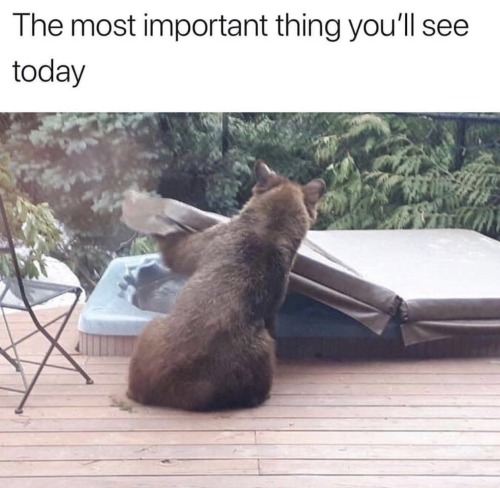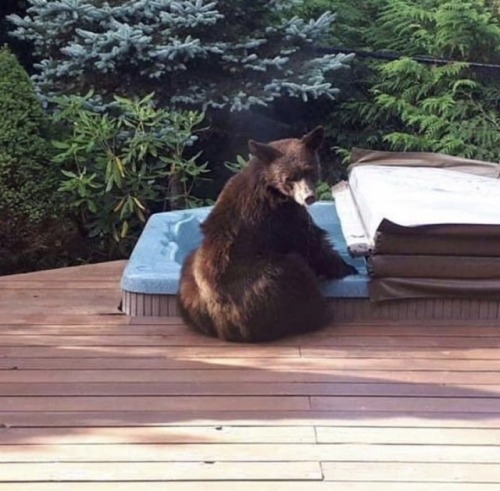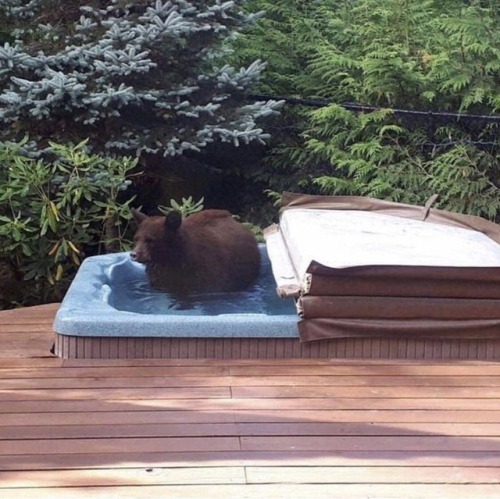The Best Thing About Working From Home
The best thing about working from home
(via)
More Posts from Linruuu and Others






vegans who refuse to even eat backyard eggs….why
every time I start thinking about lepidodendrons I always end up thinking about what it would be like to Jurassic Park one back to life and settle the 10099880 questions about how they existed once and for all
How many people can say they have played rugby with a Beluga whale? 🐳 🏉
Any time someone tells me birds aren’t descended from dinosaurs, I show them this.

Mark Oliver Everett, Things the Grandchildren Should Know
Hey just an idea but maybe instead of pushing veganism or vegetarianism on everyone in our society, we re-evaluate our society’s entire lifestyle and make changes to our individual lifestyles based on that because let’s be real: traditional veganism is not any better for the environment or physically healthier than eating animals products if you’re not doing your due diligence. By being conscientious about where all the products you buy are sourced, you can have a bigger positive impact than simply going vegan.
If you’re:
Eating sustainably/carbon negative farmed meat and/or hunting your own meat, and only eating wild caught fish
Not using sea salt due to its microplastics
Not using products containing palm oil
Eating your own cultivated organic fruit and vegetables or purchasing organic fruit/veggies
Buying honey from local beekeepers as well as having solitary bee hotels around your neighborhood
Not buying new plastic or reusing and recycling that little plastic you inevitably still have
Not purchasing brand new electronics unless 100% necessary
Buying leather or suede second hand instead of purchasing PU leather, and in general trying to purchase second hand clothes rather than buying new
Mostly using cheese and milk from a variety of animals that have lower carbon emissions than cows, ie Sheep and Goat milk
Participating in a city wide composting scheme so your food waste doesn’t go into the landfill and end up producing methane
Donating to lobbyist groups that advocate for the elimination of non-recyclable and non-compostable plastics as well as for the elimination of pesticides and toxic fertilizers
Reducing your carbon footprint by only using public transport or an electric/hybrid car
Collecting rainwater when possible
Choosing not to embalm when burying passed loved ones
Buying or making your own biodegradable soaps instead of purchasing soaps with pollutants and microplastics
Tending to eat local/native grains instead of buying grains from far away places where labor is cheap, and the nutritious food (quinoa for example) is exported rather than eaten by locals
Buying second hand furniture or only purchasing furniture that is made of solid wood and eco friendly materials instead of buying laminate and plastic furniture
Buying bamboo toothbrushes and hairbrushes instead of plastic ones
Buying personal items like bedding and underwear and sneakers and you opt for bamboo based materials instead of polyester, this goes for your mattress as well since you can buy bamboo based foam mattresses
Picking up litter you see on the street
Not smoking cigarettes due to the plastic in them nor vaping from single use cartridges
Volunteering for community wide eco-education
Doing any other eco-friendly lifestyle choice not mentioned...
... You are making a bigger impact on the world than anyone choosing to make a single change to their lifestyle like going vegan. Becoming carbon neutral and making choices that encourage carbon neutrality makes more of a difference than one single lifestyle change. Switching to an electric vehicle is meaningless if you still buy from companies using herbicides and pesticides. Eating organic is still not good enough if you let your food go to waste in a landfill. Choosing locally sourced honey over agave makes a difference (supporting small beekeepers will help maintain local bee populations). Choosing locally hunted meat over quinoa for protein makes a difference (deer populations have grown exponentially due to smaller wolf populations, and you can help your local ecology by hunting and eating them or buying from local deer hunters) but make sure that that is the right choice for you. Furthermore, something you would think is silly and unimportant, like buying wild caught fish instead of inorganic tofu can actually make a difference. Every choice you make has an impact and/or consequences. Unfortunately, it’s sometimes hard to know which choice is best, especially because we have so much misinformation on how to make the right choices. The only solution therefore, is to learn about your community and the environment in which you live. Educating oneself on which choices are best for themselves and their community’s lifestyle is something that very few people will ever take the time to do, even though it is something we really need to start doing. Buying organic fresh fruit and veg may be good for a community living in a perennially warm environment, but if you’re in a colder climate, in winter, when berries are out of season, buying organic fruits and veg might not be the best option since they’re likely to be imported via airplanes not only contributing to carbon emissions but also, they are likely to be much more expensive and unaffordable to the majority of the community. Similarly, in some parts of the world, cows milk might be the most affordable and environmentally friendly milk option, while in another part of the world, goat or sheep’s milk might be the more environmentally friendly and affordable option (side note: almond milk is almost universally never environmentally friendly, soy milk is really quite bad for you, so please choose organic rice (almost never brown rice though due to the high amounts of arsenic) or organic oat milk if you cannot have regular milk. Bonus enviro points to you if you make your own oat or rice milk btw!). So, do your research and then: use your spare time to educate your community and spread your new knowledge about how to make good ecological and health choices, call friends and family out if you see them littering or doing something wasteful, do what you can with your money to support local companies being proactively environmentally friendly, and use the power of your vote to support policies and politicians that will eventually force stagnant industries and corporations to become at the least: carbon neutral.
Dm me if you want some more interesting enviro food facts btw! There’s a whole arsenal of knowledge that I can give you!
Have fun learning to change the world folks!!
NAUTICAL NONSENSE
WHOOOOOOOO
LIVES IN A SPIRAL SHELL UNDER THE SEA?


BACKWARDS AND STRIPEY AND BUOYANT IS HE!
okay, I’d better stop before Nick L. O’deon tells me to cut it out. so here we go!
the Chambered Nautilus is an ancient deep-sea-dwelling mollusk, distant kin to both octopuses and those clams you had for lunch. they’re one of the oldest kinds of cephalopod on the planet, going all the way back to the Triassic. which, you know, 251 million years ago. (plus or minus a few million years.) they survived the extinction event that ended the reign of the dinosaurs, which also terminated their close cousin the Ammonites. these little shell dudes are true survivors.
since then, the Chambered Nautilus has bobbed its way into our collective consciousness. it inspired the very first fictional submarine, as well as an even more badass and actually-real-this-time submarine. its gorgeous shell can be found in nautical-themed restaurants worldwide. the Chambered Nautilus is a pretty big deal.

for a shellfish, anyway.
Chambered Nautilus grow to be about ten inches across the shell, which may not sound impressive but is actually an incredible feat of engineering. you’ve probably seen it before, but the Chambered Nautilus has a really trippy segmented spiral thing going on in their shell that a: makes for a great album cover, and b: creates a neutrally buoyant home that can stand the pressure of the deep sea! which is lucky, because that’s where the Chambered Nautilus lives.
these shelled little weirdos are found in the waters of the Indo-Pacific, where they live on the deep edges of coral reefs and sea canyon walls. but not below 2,600 feet, as their shells dramatically implode at that point! ha ha!

see, the nice thing about human houses? they don’t usually implode.
the Chambered Nautilus is sort of like a snail, except more complex and more backwards. (yes, I’m serious.) the soft gooey body of the Chambered Nautilus only fits in the first compartment of their shell, including their hearts, eyeballs, probable souls, various gross buoyancy organs and their roughly 90 tentacles and jet propulsion system.
yes, those last two things are totally real, I swear. let’s get into it!

I hope you like tentacles!
I’ll address the jet thing first. the Chambered Nautilus is similar to squid, in that they experience the world mostly backwards. they have a water intake valve called a hyponome which is basically a fancy tube that they keep somewhere in their tentacle zone. they use this weird pipe to draw water into an inner chamber inside their shell, and then violently squirt it right back out. this causes the Chambered Nautilus to lurch backwards at high speed like a startled raccoon.
but I didn’t even get to the best part! see, the Chambered Nautilus has very simple eyes and terrible vision. and they can’t even really see around that honkydonk badonkadonk shell anyway, so they lurch violently backwards and then bump comically into things. ALL THE TIME.

like, often enough for it to be a documented species trait. ADORABLE.
but you’ve been waiting patiently, and it’s time to get into the best part: those tentacles! and boy I sure hope you’re a fan, because the Chambered Nautilus has around 90 simple retractable tentacles called cirri. (make sure you write these down, as there will be a short quiz following this program.)
these cirri are covered in tiny ridges, like gross wet velcro spaghetti. this gives them a really absurd amount of grip, like REALLY absurd. apparently it’s easier to accidentally rip them right off the Nautilus than it is to get them off a scientist’s glove.

I’m sure that researcher felt REALLY bad afterwards.
this insane grip comes in handy (pun!) though, when the Chambered Nautilus is on the hunt. these voracious shellboys mostly eat fish, crabs and shrimp, but they aren’t above scavenging and will eat whatever is available.
once the Chambered Nautilus has spotted a likely meal, it splats itself onto it face-first like a goddam Looney Tunes character and grabs on. once they prey is snagged, it’s curtains for that particular shrimp. because like all cephalopods, the Chambered Nautilus has a razor-sharp nightmare beak hidden somewhere in all those tentacles. yum!

I mean, I’m not going to poke around in there and look so you’ll just have to trust me on this.
but the Chambered Nautilus isn’t doing so hot these days, and it’s all because of that lovely steampunk shell. its pearly luster and geometric intricacy make them prized by humans, who slaughter the Chambered Nautilus by the thousands to get them. fuck!
this shell-focused hunting has greatly decreased the Chambered Nautilus’s numbers in the past decade, and they’re almost certainly endangered now. efforts are underway to protect them, but in the meantime: DON’T BUY ANY NAUTILUS SHELLS. just get an Ammonite fossil, it’s basically the same thing but without the moral baggage or angry cephalopod ghosts.
the Chambered Nautilus survived the extinction that killed off the Ammonites and Dinosaurs, hopefully it will survive this one too.

ANGRY. CEPHALOPOD. GHOSTS.
–
thanks for reading! you can find the rest of the Weird Biology series on my tumblr here, or check out the official archive at weirdbiology.com!
if you enjoy my work, maybe buy me a coffee and support Weird Biology!
and if you’d like to see exclusive Weird Biology content, check out my Patreon today!
–
IMAGE SOURCES
img1- Monterey Bay Aquarium img2- Monterey Bay Aquarium img3- National Aquarium img4- Monterey Bay Aquarium img5- NOAA Fisheries img6- Monterey Bay Aquarium img7- Among the Reef img8- California Academy of Sciences
-
 addict-by-design liked this · 1 month ago
addict-by-design liked this · 1 month ago -
 finecallmejane reblogged this · 1 month ago
finecallmejane reblogged this · 1 month ago -
 boringbadgirl liked this · 2 months ago
boringbadgirl liked this · 2 months ago -
 stabone1988 liked this · 2 months ago
stabone1988 liked this · 2 months ago -
 hislittlething liked this · 2 months ago
hislittlething liked this · 2 months ago -
 lets-prevail reblogged this · 2 months ago
lets-prevail reblogged this · 2 months ago -
 wickedlyfun1 liked this · 2 months ago
wickedlyfun1 liked this · 2 months ago -
 abitofsunsurfsand reblogged this · 2 months ago
abitofsunsurfsand reblogged this · 2 months ago -
 abitofsunsurfsand liked this · 2 months ago
abitofsunsurfsand liked this · 2 months ago -
 heartfelt5472 liked this · 2 months ago
heartfelt5472 liked this · 2 months ago -
 randybr3001 liked this · 2 months ago
randybr3001 liked this · 2 months ago -
 all-these-colors-in-me liked this · 2 months ago
all-these-colors-in-me liked this · 2 months ago -
 sonjarenee reblogged this · 2 months ago
sonjarenee reblogged this · 2 months ago -
 deepest-dope reblogged this · 3 months ago
deepest-dope reblogged this · 3 months ago -
 soothingvibe liked this · 4 months ago
soothingvibe liked this · 4 months ago -
 rndmjs reblogged this · 6 months ago
rndmjs reblogged this · 6 months ago -
 toxicj13 liked this · 6 months ago
toxicj13 liked this · 6 months ago -
 kittyyaponia liked this · 9 months ago
kittyyaponia liked this · 9 months ago -
 demichrising liked this · 9 months ago
demichrising liked this · 9 months ago -
 theottom liked this · 9 months ago
theottom liked this · 9 months ago -
 bayleafs-corner reblogged this · 10 months ago
bayleafs-corner reblogged this · 10 months ago -
 errorexe666 liked this · 11 months ago
errorexe666 liked this · 11 months ago -
 self-sealing-stem-bolt liked this · 11 months ago
self-sealing-stem-bolt liked this · 11 months ago -
 kya-chan14 liked this · 11 months ago
kya-chan14 liked this · 11 months ago -
 czeri liked this · 11 months ago
czeri liked this · 11 months ago -
 the-dubstep-strawberry liked this · 11 months ago
the-dubstep-strawberry liked this · 11 months ago -
 squidinktea liked this · 11 months ago
squidinktea liked this · 11 months ago -
 dasburnfrau reblogged this · 11 months ago
dasburnfrau reblogged this · 11 months ago -
 thecupcakewasdelicious liked this · 11 months ago
thecupcakewasdelicious liked this · 11 months ago -
 lynnarii liked this · 11 months ago
lynnarii liked this · 11 months ago -
 lynnarii reblogged this · 11 months ago
lynnarii reblogged this · 11 months ago -
 octaviangrey reblogged this · 11 months ago
octaviangrey reblogged this · 11 months ago -
 just-pure-trash liked this · 11 months ago
just-pure-trash liked this · 11 months ago -
 stjimmyisdead reblogged this · 11 months ago
stjimmyisdead reblogged this · 11 months ago -
 ser-lovatt liked this · 11 months ago
ser-lovatt liked this · 11 months ago -
 gaeadene reblogged this · 11 months ago
gaeadene reblogged this · 11 months ago -
 aledoei1 liked this · 1 year ago
aledoei1 liked this · 1 year ago -
 akaleilovesanimals reblogged this · 1 year ago
akaleilovesanimals reblogged this · 1 year ago -
 chellings reblogged this · 1 year ago
chellings reblogged this · 1 year ago -
 gleefuldarrencrissfan liked this · 1 year ago
gleefuldarrencrissfan liked this · 1 year ago -
 oohlookakitty reblogged this · 1 year ago
oohlookakitty reblogged this · 1 year ago -
 doorslayer liked this · 1 year ago
doorslayer liked this · 1 year ago -
 coffeegleek reblogged this · 1 year ago
coffeegleek reblogged this · 1 year ago -
 notadragon reblogged this · 1 year ago
notadragon reblogged this · 1 year ago
